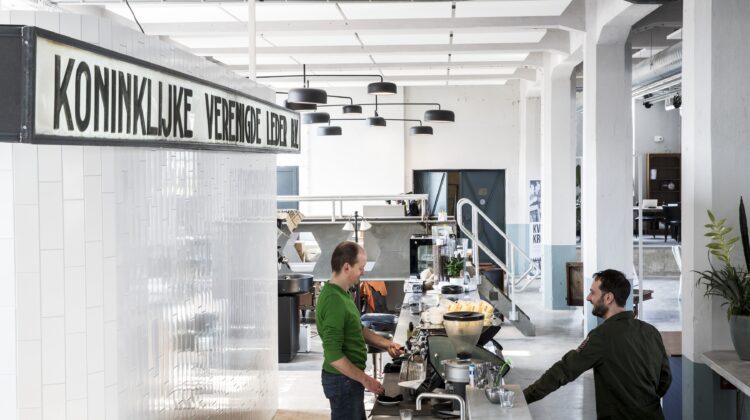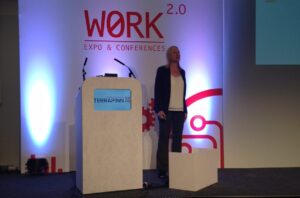

We recently attended Work 2.0 in sunny London, a conference dedicated to ‘the future of work – now’ and some trends and themes in the workplace facilities market came through particularly loud and clear.
One that we’ve already come in touch with on several occasions and that seems to just grow, day-by-day is the co-working hubs. It’s as if we’re going from a desk to activity-based working (ABW), to co-working spaces. Why are they proving so popular and what are the acoustic implications?
All about the community and ‘creative collisions’
David Fano, from WeWork, one of the giants in this area, said during his presentation that their mission was to ‘create a world where people make a life, not just a living’. The workplace is not just a place in which we work, we also want to have meaningful relationships with people there and this is one of the major benefits these co-working places bring to the table.
Most of these facilities aim to create a sense of community, of relationship building and collaboration across demographics and industries (another theme that came through during the conference). This is in fact built into the design; the (top-notch) coffee machines are placed some distance away in order to encourage you, and everyone else, to get up and walk to the same place, have a chance encounter and foster interactions. There’s also plenty of community events, both formal and more informal. All designed to give you new influences, inspiration and opportunities to interact with people who in at least some ways are different to you.
It did! Work space that moves you #work2 @WeWork pic.twitter.com/269F0caKmR
— Veronica Kingsley (@VAFKingsley) May 25, 2017
The rise of the gig economy and new way of work
Technology, of course, has a big influence on this trend too. It’s been years now since we first were able to work from a location of our choice as opposed to always coming into the office. Granted, some organisations are still struggling to realise that it’s the contribution that matters, not where this happens. And yet some, like IBM, are backtracking on previous policies in order to improve, you guessed it – collaboration! However, many individuals have probably by now also realised that working from home has its own sets of distractions and for some, a sense of disconnect. And the ‘coffice’; local coffee shop with wifi that serves good coffee and some background buzz; can be a bit too noisy or uncomfortable for extended periods. After all, it wasn’t designed for ergonomically correct computer-based work for hours on end. In addition to these flexible and/or remote workers, the gig economy adds many millions of nomad workers who often also need an office and a network to secure their income.
#Work2 Take-away @gowar_clare @philips_uk Turning the Workplace Agile, #Design and #EmployeeActivity @WORK2_Conf https://t.co/Zd57C6ElRu pic.twitter.com/uKFrmik0s4
— Condeco UK (@CondecoUK) June 13, 2017
Space as a service and tenants as customers
Another aspect that affects the built space is the flexibility of the facilities. The lobby at co-working premises can be a yoga studio in the morning, then provide workstations during the day and in the evening be transformed yet again into a lecture hall.
David Fano claimed that “businesses want what the cloud has delivered for IT for real estate”.
He was later in the day followed by John Williams from the Instant Group who claimed that ‘space is a service’ and predicted that we’d see a nichification of the co-working spaces into all-female, all tech etc. and that more brands will open up their own, perhaps underutilised, spaces for co-working, mentioning already existing examples of this such as Staples and Verizon.
Key takeaway from #work2 is about office and workspace as service and the growing awareness abt the impact of space on employee experience.
— the WorkLife HUB (@WorkLifeHUB) May 26, 2017
Six implications for acoustic design
Co-working spaces present many benefits to both individuals and companies, acoustically we can see six implications:
- A range of different spaces will require a range of room acoustic parameters to get the best solutions.
- The built-in flexibility of the spaces could present acoustic challenges if the activities have competing acoustic demands.
- Many of these co-working hubs promote wellbeing and health, the case for good acoustics should be an essential part of this.
- The need to stay connected means conference call facilities, phone booths etc. are important and hence sound privacy.
- The facilities need to be agile to keep up with demand, the acoustic solutions should, therefore, be just as agile.
- A strong focus on the visual design of the premises means a risk that acoustics is forgotten or downgraded.
I’ve visited a couple of co-working spaces where there’s basically been no or very little acoustic consideration but I also know that as a company, our solutions can be found in some. Fad or not, I guess the future will tell.
Have any of you come across these projects? What’s your take on the co-working hubs? Do they tend to do acoustics well or not?

